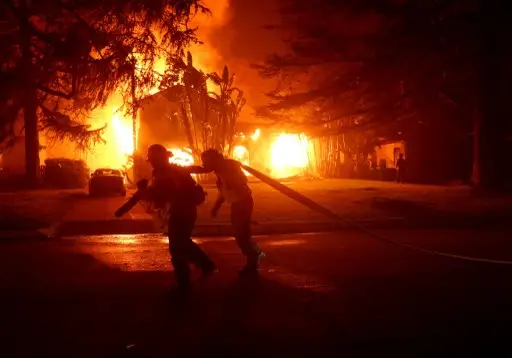LOS ANGELES, January 8, 2025 — A triple threat of wildfires has plunged Los Angeles into chaos, as thousands of residents fled their homes in search of safety. Unrelenting winds, clocked at over 100 mph, have turned neighborhoods into battlegrounds against nature, leaving destruction in their path and stretching emergency services to their limits.
The fires, which erupted across Pacific Palisades, Altadena, and Santa Clarita, have already devoured thousands of acres. In Pacific Palisades, known for its stunning vistas and celebrity homes, the flames claimed dozens of properties overnight. Residents barely had time to escape as fiery embers leapt through the air, igniting roofs and trees at an alarming speed.
Among those evacuating was actor James Woods, who shared footage of the inferno creeping toward his hillside home. “We never thought this would be our reality,” Woods wrote on social media, his heartbreak echoed by thousands who watched their communities burn.
Fire crews, already stretched thin, faced additional challenges as water supplies in key areas fell short. In Altadena, elderly residents were rushed out of care facilities as the Eaton fire grew to over 2,000 acres. Nearby, in Santa Clarita, emergency teams scrambled to establish containment lines against a separate blaze.
Mayor Karen Bass has called for a state of emergency, warning residents to remain vigilant. “These winds and conditions are unlike anything we’ve faced in years,” Bass said. “Your safety is our top priority.”
The wildfires have not only impacted homes but also the city’s cultural and entertainment landscape. Events were canceled citywide, including the highly anticipated premiere of Jennifer Lopez’s new film, “Unstoppable.”
While federal agencies, including FEMA, stand ready to assist, the situation has reignited discussions about Southern California’s vulnerability to wildfires. Experts say a dangerous mix of human-driven climate change and recent weather extremes have made the region more susceptible than ever.
Years of drought, followed by back-to-back rainy seasons, created the perfect storm: lush vegetation that dried into tinder under relentless heat. Scientists argue that this cycle is becoming the norm as global temperatures rise, demanding new approaches to urban planning, fire management, and resource allocation.
As smoke clouds the Los Angeles skyline, residents are left wondering how to rebuild not just homes, but their sense of safety. For now, the battle continues, with firefighters, city officials, and communities working together to protect what remains.






